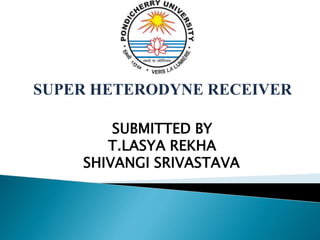
Superhetrodyne receiver
- 1. SUPER HETERODYNE RECEIVER SUBMITTED BY T.LASYA REKHA SHIVANGI SRIVASTAVA
- 2. Intercept the electromagnetic waves in the receiving antenna to produce the desired RF modulated carrier. Select the desired signal and reject the unwanted signal. Amplify the RF signal. Detect the RF carrier to get back the original modulation frequency voltage. Amplify the modulation frequency voltage
- 3. Simplicity of operation Good fidelity Good selectivity Average sensitivity Adaptability to different types of aerials
- 8. Pre RF Section IF Section selector RF amplifier Mixer / Converter Section Mixer IF Amplifier Band pass filter AM Detector Audio Amplifier Local Oscillator Audio detector Section Audio amplifier Section RF signal Gang tuning speaker IF signal Audio Frequencies
- 9. Heterodyne receiver has five sections RF section Mixer/converter section IF section Audio detector section Audio amplifier section
- 10. Preselector stage Broad tuned band pass filter with adjustable frequency that is tuned to carrier frequency Provide initial band limiting to prevent specific unwanted radio frequency called image frequency from entering into receiver. Reduces the noise bandwidth of the receiver and provides the initial step toward reducing the over all receiver bandwidth to the minimum bandwidth required to pass the information signal.
- 11. It determines the sensitivity of the receiver. RF amplifier is the first active device in the network it is the primary contributor to the noise. And it is the predominant factor in determining the noise figure. Receiver may have one or more RF amplifier depending on the desired sensitivity.
- 12. Greater gain and better sensitivity Improved image frequency rejection Better signal to noise ratio Better selectivity.
- 13. It consists of two components Mixer Local oscillator Mixer stage : Heterodyning takes place in the mixer stage. Radio frequencies are down converted to intermediate frequency Carrier and sidebands are translated to high frequencies without effecting the envelope of message signal.
- 14. Frequency conversion The difference between the RF and Local oscillator frequency is always constant IF. High side injection Low side injection Local oscillator frequency is tuned above RF Local oscillator frequency is tuned below RF f LO = fRf + fIF f LO = fRf - fIF
- 15. RF-to-IF conversion Receiver RF input (535 – 1605 kHz) Preselector 535 - 565 kHz Mixer IF filter 450 – 460 kHz Oscillator 1005 kHz 535 545 555 565 kHz 440 450 460 470 kHz 450 460 kHz IF Filter output high-side injection (fLO > fRF) lo RF IF f f f
- 16. The adjustment for the center frequency of the preselector and the adjustment for local oscillator are gang tuned. The two adjustments are mechanically tied together and single adjustment will change the center frequency of the preselector and the local oscillator
- 17. TRACKING: It is the ability of the local oscillator in a receiver to oscillate either above or below the selected radio frequency carrier by an amount equal to the IF frequency through the entire radio frequency band.
- 18. Tracking error: the difference between the actual local oscillator frequency to the desired frequency. The maximum tracking error 3KHz + or -. Tracking error can be reduced by using three point tracking. The preselector and local oscillator each have trimmer capacitor in parallel with primary tuning capacitor that compensates for minor tracking errors in the high end of AM spectrum. The local oscillator has additional padder capacitor in series with the tuning coil that compensates for minor tracking errors at the low end of AM spectrum.
- 19. Image frequency :It is any frequency other than the selected radio frequency carrier that is allowed to enter into the receiver and mix with the local oscillator will produce cross product frequencies that is equal to the intermediate frequency. flo =fsi+fif → fsi=flo-fif when signal frequency is mixed with oscillator frequency one of the by products is the difference frequency which is passed to the amplifier in the IF stage. The frequency fim= flo+fsi the image frequency will also produce fsi when mixed with fo . For better image frequency rejection a high IF is preferred. If intermediate frequency is high it is very difficult to design stable amplifiers.
- 20. 2fif fif fif IF IM RF LO SF frequency Image frequency rejection ratio It is the numerical measure of the ability of the preselector to reject the image frequency. Single tuned amplifier the ratio of the gain at the desired RF to the gain at the image frequency. IFRR Q RF im im f RF f f f 2 2 1 (
- 21. If the IF is too high Poor Selectivity and Poor adjacent channel rejection. Tracking Difficulties. If the IF is too low Image frequency rejection becomes poorer. Selectivity too sharp and cutting off sidebands Instability of oscillator will occur.
- 22. It contains detector and AGC or AVC Detector: Rectifies the modulated signal, then filters out the 455 KHz. Leaving only the audio frequency or intelligence of 50 Hz – 20 KHz Which is sent to the AF amplifiers. Automatic Volume Control or gain control is taken at the detector (demodulated and fed back to the first IF amplifier base). Required to overcome atmospheric and terrain conditions that adversely affect signal strength between the transmitter & receiver.
- 23. The resultant audio signal is amplified in this section and fed into the output device(ex: loudspeaker)…… In this section we have Audio preamp stage Audio driver stage Audio push pull stage
- 24. Double superheterodyne receiver Although the basic idea for the superheterodyne receiver works very well, to ensure the optimum performance under a number of situations, an extension of the principle, known as the double superheterodyne radio receiver may be used. Improves image rejection ratio and adjacent channel filter performance.
- 25. After invention of superheterodyne,there are many inventions but it is the best receiver…..